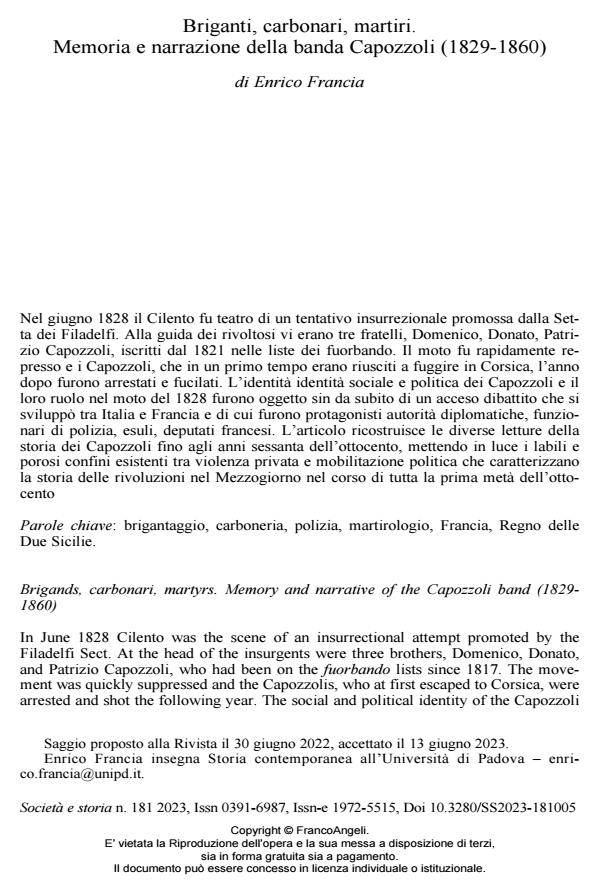Brigands, carbonari, martyrs. Memory and narrative of the Capozzoli band (1829-1860)
Journal title SOCIETÀ E STORIA
Author/s Enrico Francia
Publishing Year 2023 Issue 2023/181
Language Italian Pages 22 P. 481-502 File size 252 KB
DOI 10.3280/SS2023-181005
DOI is like a bar code for intellectual property: to have more infomation
click here
Below, you can see the article first page
If you want to buy this article in PDF format, you can do it, following the instructions to buy download credits

FrancoAngeli is member of Publishers International Linking Association, Inc (PILA), a not-for-profit association which run the CrossRef service enabling links to and from online scholarly content.
In June 1828 Cilento was the scene of an insurrectional attempt promoted by the Filadelfi Sect. At the head of the insurgents were three brothers, Domenico, Donato, and Patrizio Capozzoli, who had been on the fuorbando lists since 1817. The movement was quickly suppressed and the Capozzolis, who at first escaped to Corsica, were arrested and shot the following year. The social and political identity of the Capozzoli and their role in the 1828 movement were immediately the subject of a heated debate that developed between Italy and France and involved diplomatic authorities, police officials, exiles, and French deputies. The article recounts the different readings of the Capozzoli story up to the 1860s, highlighting the blurred and porous boundaries between private violence and political mobilization that characterize the history of revolutions in the Mezzogiorno throughout the first half of the nineteenth century
Keywords: brigandage, carbonari, police, France, martyrology, Kingdom of the Two Sicilies.
- Alonso Cabezas M.V. (2018), Beardless Young Men? Facial Hair and the Construc- tion of Masculinity in Nineteenth-Century Spanish Self-Portraits, in New Perspec- tives on the History of Facial Hair Framing the Face, a cura di J. Evans, A. With- ey, London, Palgrave, pp. 91-108.
- Autuori M. (1988), Storia sociale della banda Capozzoli (1817-1827): lotte municipa- li e brigantaggio in Il Mezzogiorno preunitario: economia, società e istituzioni, a cura di A. Massafra, Bari, Edizioni Dedalo, pp. 1127-1141.
- Brofferio A. (1850), Storia del Piemonte dal 1814 ai giorni nostri, Torino, Pompeo Magnaghi.
- Burges G (2008), Refuge in the Land of Liberty. France and its Refugees, from the Revolution to the End of Asylum, 1787–1939, Basingstoke, Palgrave-MacMillan.
- Castellano C. (2022), Cilento 1828: anatomia di una rivolta carbonara, in «Passato e Presente», 115, pp. 105-123.
- Conti F. (2014), The Religion of the Homeland. The Cult of “Martyrs of Freedom” in Nineteenth-century Italy, in «Journal of Modern European History», 3, pp. 398-418.
- Conti F. (2020), At.to Vannucci in Dizionario Biografico degli Italiani, Volume 98, Roma, Istituto della Enciclopedia italiana.
- Delpu P.-M. (2019), Un autre Risorgimento. La formation du monde libérale dans le royaume des De Deux-Siciles, Rome, Ecole Française de Rome.
- Delpu P.-M. (2017), Une religion politique. Les usages des martyrs révolutionnaires dans le royaume des Deux-Siciles (années 1820-années 1850) in «Revue d’Histoi- re Moderne et Contemporaine», 64, pp. 7-31.
- Diaz D. (2014), Un asile pour tous les peuples ? Exilés et réfugiés étrangers dans la France au cours du premier XIXe siècle, Paris, Armand Colin.
- Diaz D. (2018), L’affaire Galotti (1829). Exil, extradition et «droit d’asile», in «Orages», 17, p. 125-140.
- Didier C. (1831), Les frères Capozzoli et la police napolitaine in «Revue des Deux Mondes», 2, pp. 374-382.
- Didier C. (2007), Rome souterraine, edizione critica a cura di S. Guermés, Genève, Droz.
- Francia E. (2011), Eroi, soldati e popolo. Narrative patriottico-militari nell’Italia del Risorgimento, in Guerre e culture di guerra, a cura di P. Del Negro e E. Francia, Milano, Unicopli, pp. 35-60.
- Galotti A. (1831), Mémoires de Antonio Galotti, officier napolitain, condamné trois fois à mort / écrits par lui-même;; traduit par S. Vecchiarelli, réfugié italien, Paris, s. e.
- Galzerano G. (1998), Le “Memorie” di Antonio Galotti. La rivolta del Cilento del 1828, Casalvelino Scalo, Galzerano editore.
- Gualterio F. A. (1852), Gli ultimi rivolgimenti italiani. Memorie storiche, Firenze, Le Monnier.
- Janz O. e Klinkhammer L. (a cura di) (2008), La morte per la patria. La celebrazione dei caduti dal Risorgimento alla repubblica, Roma, Donzelli Editore.
- La Cecilia G. (1851-1852), I fratelli Capozzoli. Domenico, Patrizio e Donato, in Panteon dei martiri della libertà italiana, opera compilata da varii letterati, pubblica- ta per cura di una società di emigrati italiani, Torino, Fontana, vol. I, pp. 332-341.
- La Cecilia G. (1876), Memorie storico-politiche dal 1820 al 1876, Roma, Artero.
- La Farina G. (1851), Storia d’Italia dal 1815 al 1850, Torino, Società Editrice Italiana. Mastroberti F. (2005). Tra scienza e arbitrio. Il problema giudiziario e penale nelle Sicilie tra il 1821 e il 1848, Bari, Cacucci.
- Mazziotti M. (1906) La rivolta del Cilento nel 1828 narrata su documenti inediti, Roma-Milano, Società editrice Dante Alighieri.
- Micchitelli F. (1860), Storia delle rivoluzioni ne’ reami delle due Sicilie, Italia, senza editore.
- Monnier M. (1874), Genève et ses poètes: du XVIe siècle à nos jours, Paris-Genève, Sandoz et Fischbacher.
- Moscati R. (1933), La rivolta del Cilento del 1828, in «Archivio storico per la provin- cia di Salerno», 2, pp. 127-185.
- Oldstone-Moore C. (2016), Of Beards and Men. The Revealing History of Facial Hair, Chicago, Chicago University Press.
- Petrusewicz M. (1998), Come il Meridione divenne una Questione. Rappresentazioni del Sud prima e dopo il Quarantotto, Soveria Mannelli, Rubbettino.
Enrico Francia, Briganti, carbonari, martiri. Memoria e narrazione della banda Capozzoli (1829-1860) in "SOCIETÀ E STORIA " 181/2023, pp 481-502, DOI: 10.3280/SS2023-181005